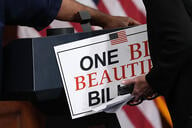You have /5 articles left.
Sign up for a free account or log in.
Rising numbers of community college students kept total enrollment across all sectors of higher education flat this spring despite a decline in the largest category of institutions by share of enrollment: public four-year universities.
Data released today by the National Student Clearinghouse Research Center come after enrollment declines at colleges and universities across the country during the COVID-19 pandemic. The preliminary data offer a peek at spring 2023 enrollment compared to spring 2022.
In fall 2022, the undergraduate enrollment decline slowed to 0.6 percent, according to Clearinghouse data, and, over all, “I think stabilization is still pretty much where we are,” said Doug Shapiro, executive director of the organization's research center.
Community college enrollment increased by 2.1 percent this spring compared to a year earlier, and undergraduate enrollment at private four-year institutions also increased, rising by 0.8 percent at nonprofit institutions and 2.2 percent at for-profit institutions.
But four-year public universities’ undergraduate enrollment fell by 0.9 percent, and Shapiro noted that roughly 45 percent of all students in higher education attend such institutions.
The data revealed some trends, including how enrollments in both undergraduate and graduate certificate programs increased compared to last spring, while there was a 0.6 percent decline in the number of students seeking bachelor’s degrees.
But the new report is considered preliminary, as it’s based on data representing just over half of the students whose information is reported to the clearinghouse, with a more comprehensive report to be released later this spring. Researchers not involved with the report cautioned against drawing too many conclusions from limited data.
Michael Miller, a professor of higher education at the University of Arkansas at Fayetteville, said data that lump together all four-year public universities miss major differences between types of institutions. He noted that while large public institutions and state flagships are doing relatively well on enrollment, many less-selective regional public colleges and universities are struggling.
“Kind of the big, brand-name institution has done really well,” Miller said. The University of Arkansas and some other state flagship universities have recently reported enrollment increases.
“It’s a very consumer-driven market. People want to have a big brand name,” Miller said.
The greatest enrollment declines at four-year public universities by percentage were among older students, according to the report. The number of female undergraduate students age 25 to 29 dipped by 7.5 percent compared to a year earlier; the decline was 6.2 percent among male undergrads of the same age.
The number of part-time undergraduate students at four-year public universities declined by 4.8 percent compared to a year earlier, while the number of full-time students actually remained unchanged.
Mikyung Ryu, director of research publications for the National Student Clearinghouse, cautioned, however, against drawing any conclusions that public university declines could solely be explained by a decrease in part-time enrollees.
“We will acknowledge that part-time enrollment is a driving force,” she said. But she also noted that data spanning more than a year “probably tells a more complete” story, and such data showed a 1.8 percent decline in full-time students at such universities over the last two years.
Sean Gallagher, executive director of the Center for the Future of Higher Education and Talent Strategy at Northeastern University, said demand for short-term education options, such as certificates, is outpacing demand for longer degree programs.
Still, only a relatively small “fraction” of higher education students enroll specifically for certificate programs, Gallagher said.
“In a number of categories, the degree enrollments are down or flat, so I think that reflects some shifting preferences on the part of students,” Gallagher said of data that showed a 5.5 percent increase in enrollment in undergraduate certificate programs compared to a year ago and a 4.6 percent increase in graduate certificate programs.
Other trends included a 2.1 percent increase in undergraduate students aged 18 to 20. The numbers also showed an overall gain in male students, though that was offset by a drop in female enrollment. The data on race and ethnicity of undergraduates showed a rise only in the number of Latino students, with enrollment for other groups declining or remaining stable.
Shapiro noted the enrollment growth at community colleges comes in part from high school students dually enrolled for college credit, but there also was a 13.5 percent increase in new freshman enrollment at community colleges this spring.
“A particularly encouraging point here is that the freshman growth included all age groups,” Shapiro said. “In fact, some of the largest jumps were among older first-time students. And that reverses what has been a stark divide, especially in last spring’s freshman numbers, which were up for 18- to 20-year-olds, but down for all other ages at community colleges.”
John Fink, a senior research associate at the Community College Research Center of Teachers College at Columbia University, said the spring term at a community college differs from that of a four-year institution.
“The majority of community college students enter in the fall, but there’s a very large number who start in the spring every year, and that’s sort of always been the case,” he said.
Fink said community college enrollment declines began years before the COVID-19 pandemic, which hit two-year enrollments especially hard.
“Enrollments are really in sort of a deep hole. It’s definitely moving in the right direction, but there’s a lot of ground to make up,” Fink said.
While small percentage changes in enrollment by gender carry over trends from this past fall, they hardly put a dent in the gender gap that’s emerged over decades in higher education, where women far outnumber men in undergraduate enrollment. Female students made up 58 percent of total undergraduate enrollment, according to recent federal data.
Community college gains appeared to be largely due to men, with the clearinghouse data showing a 3.7 percent increase in male enrollment compared to a 0.1 percent increase in female enrollment. However, Fink noted the difficulties in making sense of such limited data, with sorting by gender often “community specific” as well as “program specific.” He said more analysis would be needed to understand why the data showed an increase in male students.
Miller believes private liberal arts colleges, as well as community colleges, are trying harder to recruit male students in particular, in part by offering more sports participation options. Bethany College in Kansas, a private Christian college, for example, has 373 participants on men’s athletic teams, or more than 90 percent of all male students, which Miller said is an example of a creative way to try to boost enrollment.
The clearinghouse data show that nationally, the number of male undergraduates increased by 1.3 percent at four-year private, nonprofit institutions, while female undergraduate enrollment increased by 0.1 percent.
Latino undergraduate enrollment increased by 0.9 percent this spring while other major racial and ethnic groups showed no gains or continued declines.
Roxanne Garza, a senior policy adviser for education with the advocacy organization UnidosUS, said the growth in enrollment is good.
“But when you look at where we are compared to 2019, we’re still at a deficit,” Garza said.
She said Latino college enrollment had been on the rise before the emergence of COVID-19, but “we know that Latinos were one of the groups that were hardest hit by the pandemic in terms of job loss or loss of income.”
UnidosUS is advocating for an increase in the federal Pell Grant as well as other federal aid, she said, with concerns about keeping tuition and fees in check but also about whether colleges are “also thinking about basic needs, making sure students’ basic needs are met.”




